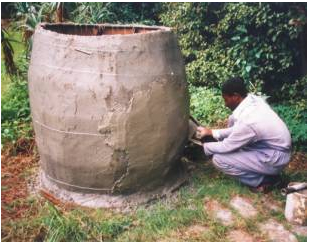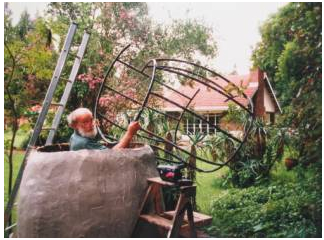Difference between revisions of "Small household ferrocement tanks (jars)"
(→Suitable conditions) |
|||
| Line 6: | Line 6: | ||
==Suitable conditions== | ==Suitable conditions== | ||
| − | {| border="1" cellpadding="5" cellspacing="0" align="none" | + | {| border="1" cellpadding="5" cellspacing="0" align="none" width="50%" |
|- | |- | ||
! width="25%" style="background:#efefef;" | Advantages | ! width="25%" style="background:#efefef;" | Advantages | ||
Revision as of 05:30, 26 May 2013

The small ferro-cement tank or pitcher is a simple type of tank with several uses. Firstly it can be used as a triple septic chamber. It can also be used as an underground tank or domestically for water storage. It can be made in various different sizes as appropriate.
Suitable conditions
| Advantages | Disadvantages |
|---|---|
| - Easy to construct. - Uses easily available materials. |
- The storage tank is the most expensive part of a roof rainwater system, and often they cannot hold enough water for whole dry season. Making bigger tanks is possible but more difficult and cost can be too high, which would make them not replicable on a larger scale. |
Resilience to changes in the environment
Drought
Effects of drought: Badly made concrete and cracked linings (e.g. in tanks, dams, waterways, wells, and other structures).
Underlying causes of effects: Less water used for curing; Impure water used for mixing.
To increase resiliency of WASH system: Ensure adequate mixing, ratios, purity of ingredients; Minimize water content in mixture; Ensure adequate curing.
For more information on drought: Resilient WASH systems in drought-prone areas
Construction, operations and maintenance




The tank consists of a concrete base slab, side walls made of ferrocement and a thin lid also made of concrete. A tap is fitted through the lower side wall to deliver the water. The jar uses three 50kg bags of cement together with river sand and pit sand. Fine chicken wire and 3mm plain wire is also used as reinforcing.
The concrete base
This is made over an area of levelled ground in strong concrete with a mix of 3 parts stone, 2 parts river sand and one part cement. The base is made 1.5m in diameter and 75mm thick. Bricks can be used to contain the concrete in the form of a mould. A series of 3mm wires are placed in a grid formation within the concrete, about half way up. The base is covered and left for one week to cure and kept wet at all times after hardening. The tank will be built on top of this base.
The ferrocement side walls of the tank
This are built up around a frame made in this case of 25mm polyethylene pipe fitted together with polyethylene tee pieces to form a barrel shaped frame – see photo. The frame is made so it is 1.2m high and both base and top have a diameter of 1.2m. In this case 10 uprights have been made. The barrel shape, which helps to strengthen the final jar, is produced by using wires tensioned between top and bottom rings. Once the frame is made, this is overlaid by sheets of hessian or sacking which can be wired onto the frame. The frame is then placed over the concrete base.
The application of a thin slurry of cement and pit sand can then begin. In fact the very first layer can be cement liquefied with water for form a paint called NIL. New layers of very thin slurry made by mixing cement (one part) and pit sand (2 parts) are added using a brush, the liquor being flicked on. Two or three layers are built up and left to cure and harden to form a shell over which the chicken wire can be placed, and then mortared with a mix of river sand and cement.
The chicken wire is formed around the tank walls and held down with rings of 3mm wire. This is followed by the plastering stage using a mix of cement (one part) and river sand (three parts). The strong mortar is trowelled through the chicken wire. Two layers are applied to make the tank wall about 25mm thick. The concrete work, once hardened is left to cure under plastic sheet and is kept wet for a week.
Removing the frame and Hessian
Once cured the frame can be unwired and removed from within the jar. Also the Hessian is removed. The a final internal layer of strong cement mortar using 2 parts pit sand and one part cement can be applied to the internal surface of the tank and base to form a water tight layer. This is left to cure.
The water outlet pipe and tap
This is made with half inch (15mm) galvanised steel pipe and a brass tap. The pipe should be about half a metre long. It is also advisable to thread an elbow at the end of the pipe facing upwards. A hole is chiselled in the lower part of the tank at a suitable point. The pipe is then inserted through the hole. It is very important that the pipe and tap are well secured and stable. To do this, the pipe is laid in its final position about 40mm above the tank floor and a mould made of bricks is placed around the pipe, leaving the end of the pipe free. Once the pipe is fitted, strong cement mortar made with a mix of 3 parts river sand and one part cement is placed around the pipe within the mould. This should be placed right up to the tank wall. The concrete should surround the pipe around 50mm all round. Wires placed within the concrete help it to stop cracking later. This concrete is left to cure and the outer tank wall is also plastered at the point where the pipe protrudes. The tap securing concrete is allowed to cure for several days, being kept wet once it has hardened.
A hole is made in the ground below the tap large enough to contain a 10 litre bucket which will be used to collect water and take it into the house. This hole is lined with strong cement mortar.
The lid
Meanwhile a thin concrete lid made to fit the top of the jar is made. A piece of ground is levelled and plastic sheet laid down and bricks laid in a circle 1.2m in diameter. Chicken wire can be used as reinforcing or strands of 3mm wire laid 150mm apart in a grid formation. The mix should be 3 parts river sand and one part cement. The cement lid is build up to about 30mm thickness. Half the mix is added first, then the wire, then the final half of the concrete mix. A hole 30cm in diameter is formed in the centre of the slab for a water inlet.
The water inlet system
It is important that water passing into the tank should pass through a fine gauze, sieve or filter to strain out foreign objects, such as insects (ants etc) and leaves. This can be achieved by cementing a 10 litre plastic bucket into the top slab and building up at the sides with cement mortar. This is shown in the photos. A hole is made in the base of the bucket and a fine stainless steel filter fitted. In this case a tea strainer has been used. The bucket handle has been removed and the plastic rim of the strainer which holds the stainless steel mesh is bonded to the base of the bucket. Water entering the jar is led through this bucket and filter. It is important that insects and other life and leaves etc cannot enter the tank. A concrete lid is also made to fit over the water inlet system.
Fitting the top slab
Once the top slab and water inlet system have been completed and cured the top slab can be fitted and is bonded to the side walls with strong cement mortar. The system should not allow ants or other insects to invade the interior of the tank. This mortar is allowed to cure.
Curing and finishing off
The whole tank is allowed to cure and can be painted. Water can then be allowed in from the most convenient source of rainwater. Being made of concrete, the jar will last for many years – a good investment in time and money. If necessary a second jar can be made if more rainwater is required.
Costs
- Water jars from brick - US$78 per m3 storage (0.7 m3 for US$55)275.
- Water jars from ferrocement - US$50 - US$97 per m3 storage (3m3 for US$150, 0.5m3 for US$46.5276)
- In Bolivia, the cost of construction of a tank of 200L is about US$10
Field Experiences
Bolivia, India
Manuals, videos, and links
tank and sink</font>
- The video on the right shows how to make a small (75 liter) ferrocement water tank and a sink for use in the house, EMAS style.
- Akvo solution of the week 8
- Water supply in small communities, by Lara Fabrizi. Includes how best to manage the planning, construction, and operation and maintenance of water projects or tanks.
Acknowledgements
- Building a ferrocement rainwater jar. Aquamor.
- Buchner, Wolfgang. EMAS Manual Water for Everybody. EMAS Water and Basic Sanitation Mobile School. 5th Edition, 2006.
- CARE Nederland, Desk Study: Resilient WASH systems in drought-prone areas. October 2010.

